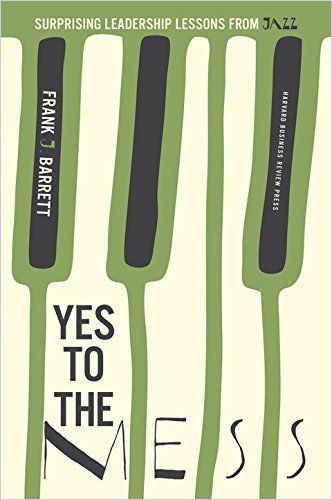Jazz musician and professor of management and global public policy Frank J. Barrett, PhD offers a valentine to jazz that guides leaders to embrace improvisation.

Free Like Jazz
Frank J. Barrett, PhD, professor of management and global public policy at the Naval Postgraduate School in Monterey, California, is an accomplished jazz musician. He makes a compelling and original case that organizations can learn from improvisational jazz in terms of embracing collaborative experimentation and discovery. Jazz bands improvise without rigid leadership by any one musician, he explains, and players maintain positive expectations, despite mistakes.
Barrett warns that control suppresses creativity and that today’s fast-paced change undermines planning. Therefore, he says, firms can gain from the example of jazz. Improvisational leaders say “yes to the mess” by encouraging collaboration and seizing opportunities.
USA Today wrote, “Barrett makes an engaging and convincing case that the leadership style that it takes to make great jazz can also make business more innovative and successful.” 800 CEO Read called this, “A short but powerful book about how to be more focused at work, how to understand chaos as an opportunity, and how to be better prepared to approach it.” And Forbes found it, “breezy and fun.”
Improvisational Jazz
Barrett suggests that the 21st century data-based economy requires organizations to perform more like jazz bands by encouraging employees to innovate and learn rather than laboring under preconceived constraints. This would mean, he explains, that companies could undertake creative action and calculated risks, even when faced with incomplete information and unpredictable results.
Jazz improvisers focus on discovery in times of stress.Frank Barrett
Great jazz soloists, Barrett shares, embrace the paradox of improvisation. Poetically, he says musicians – and leaders – who improvise will experience fear and exhilaration at the edge of mystery.
The author provides an illustrative anecdote about Hungarian soldiers lost in the Alps. Some soldiers had given up hope and expected to die when one found a forgotten map in his pocket. Only after their safe return did the soldiers realize the map that saved them depicted the Pyrenees mountains in Spain, not the Alps. Barrett uses this tale to exemplify how a group’s members can gain confidence by adopting “any plan,” and revising it as their requirements shift.
Sometimes, he posits, learning is most vivid in a crisis that forces managers to act like jazz musicians – to forget habit and simply deal with an unfolding, ongoing situation. Barrett cites the classic jazz album, The Bridge, recounting that saxophonist Sonny Rollins created the music alone under a Manhattan bridge, forcing himself to play in ways he’d never played before, and stopping if he started a familiar pattern. This story is one of several jazz anecdotes that will have jazz fans nodding in recognition.
Honey on the Roof
Barrett tells the story of office furniture manufacturer Herman Miller, who designed a “green” factory that used energy and water efficiently and minimized pollution and waste. However, he reveals, the soil, flowers and vegetables on the rooftop drew colonies of hostile wasps. Instead of killing the wasps with pesticide, the company put hives holding 600,000 bees on the roof. The bees drove away the wasps and filled the rooftop hives with honey. Barrett slightly stretches a point when he says that jazz musicians comparably overcome uncertainty by embracing positive thinking. Not every example he raises bears a direct comparison to jazz, but this is another great story, and now the manufacturer gives visitors jars of honey.
By saying yes to the mess and valuing the art of improvisation, leaders can create conditions for guided autonomy. Frank Barrett
Barrett offers a useful analogy when he cites how jazz works best when each musician constantly considers what the others are playing as a framework for his or her musical choices. Such interplay helps a band achieve a groove – a group dynamic that transcends individual performance.
Make the Most of Mistakes
Rather than reprimanding a player who messes up, Barrett divulges, other players take errors in stride and improvise. He recounts, for example, that renowned keyboardist Herbie Hancock heard trumpet legend Miles Davis mistake one chord for another, so Hancock played a solo based on the “wrong” chord, turning a mistake into what seemed to be a planned pivot in the song.
Investments in minimal rules that free employees to meet challenges by deviating from normal practice are investments in organizational learning.Frank Barrett
Barret holds that organizations should adopt a minimal structure in the form of a mission statement, slogan, credo or trademark. Minimal structure provides a frame but keeps rigid rules from dimming employees’ imaginations and limiting their creativity.
Social Interaction
Social interaction among diverse people with a mix of skills – essentially, Barret believes, a jam session – is more likely to lead to a transformative innovation than the work of a solitary genius. His parallel thought is that in successful jazz improvisation, each band member both leads and follows.
Designing opportunities for serendipity is another way to say yes to the mess. Frank Barrett
Instead of making rational decisions on the basis of analysis and prediction, jazz band leaders, Barrett reiterates, encourage experimentation. Organizational leaders should inspire their people to abandon habit and consider novel approaches.
Disrupt the Routine
Barrett offers steps organizations can take if they seek to achieve peak performance by comparing their work to improvisational jazz. He recommends linking planners with those who act and implement; disrupting routines to trigger creative surprises; finding more ways to say “yes”; rotating team leadership; minimizing organizational structures; encouraging a playful approach; holding jam sessions for diverse groups to brainstorm; and nurturing improvisational strategizing and nonstop learning.
Play That Thing
Barrett loves jazz. If you love jazz, you are likely to enjoy this work more for the jazz stories than for their applicability to business. If you are a business leader who knows nothing of jazz, Barrett might convince you to incorporate certain improvisational techniques into your employees’ daily work habits.
However, even given this work’s brevity, and its longevity as a leadership favorite, Barrett reaches the limits of his concept pretty quickly, sometimes repeating himself as he strives for increasingly less likely links between jazz and opening an office up to more creative approaches. Still, the idea holds up, and he offers a fun read of genuine imagination.
Other unconventional leadership books include The Fifth Discipline: The Art and Practice of the Learning Organization by Peter M. Senge; Dialogue: The Art of Thinking Together by William Isaacs; and Creativity Inc.: Overcoming the Unseen Forces that Stand in the Way of True Inspiration by Ed Catmull.





